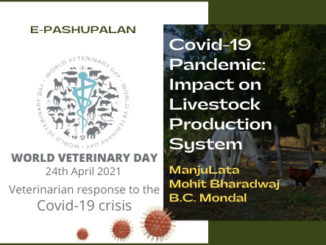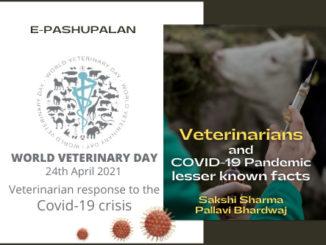The classical view of a Veterinarian as a person qualified to practice Veterinary Medicine has lead most of the people to think that their clinical practices are associated with the prevention, cure or alleviation of pain and treatment of injuries in animals, especially companion animals and livestock. Though these roles are vital, the contemporary roles undertaken by veterinarians go far beyond these more visible tasks. It must be recognized that as the world becomes intricately inter-connected and more complex, so are the various obligations and responsibilities that veterinary professionals must undertake.
Over the years Veterinary professionals have played significant and contributory roles in animal and human health and welfare, biomedical research, food quality, food safety, food security, ecology, epidemiology, microbiology, parasitology, pathology, physiology, radiology, research and development of pharmaceuticals, remedies, vaccines, and toxicology; also as educators, trainers, and policymakers, and also interlinked with wildlife conservation efforts and the protection of the environment and biodiversity.
Among the health care professions, Veterinary medicine is unique in contributing to human, environmental, and animal well-being. These broad contributions are possible because veterinarians are trained in enhancement of the health, utility, and productivity of domestic and wild animals, and also are mandated to assist humans and society through the veterinarians’ oath. As challenges have risen, veterinarians have found ways to adapt as long as their knowledge and training makes them multifunctional professionals. This aids societies so that its animals stay healthy and productive. The role of Vet does not limit here; they also play important role in disaster management.
The World Health Organization defines disaster as ‘any occurrence that causes damage, economic destruction, loss of human life and deterioration in health and health services on a scale sufficient to warrant an extraordinary response from outside the affected community or area’. It is an event, concentrated in time and space, which causes social, economic, cultural and political devastation and which affects both individual people and communities.
No disaster is exactly the same as another and the impact and consequences vary from region to region and community to community.
Disasters can be categorized, according to what causes them, as natural disasters, i.e. the result of natural phenomena, or manmade disasters, i.e. the result of man’s intervention or nonintervention. Natural disasters account for nearly 80% of all disasters that occur in the world. Disasters can also be classified, according to their impact, as localized, widespread, predictable or unpredictable, and also, major or minor.
The impact of a disaster can be categorized as direct, indirect or tertiary. Apart from the general public health consequences of disasters, like zoonotic diseases and threat to the food supply, disasters also have negative economic consequences, particularly in developing countries. Livestock provide milk, meat, traction power for farming and transport, dung, hides, wool, fiber, etc., animals also provide a relatively safe investment option and give the owner social importance. Disasters affecting livestock have a negative impact on the infrastructure of a country, reducing critical sources of income in rural areas and hindering the distribution of food and goods. So there is high need of Veterinarian’s to take action and reduce the disaster effects.
The four basic components of disaster management are
- Mitigation
- Preparedness
- Response / Emergency relief
- Veterinarians, animal health technicians and veterinary support staff all have unique skills which will serve each of those four phases.
Mitigation
Actions taken before a disaster can reduce the impact on animals. Expected natural disasters should be planned for. For example, planning for floods should include:
- Identifying locations to which animals may be evacuated, the means of transport, animal identification measures, access to restricted areas for transportation equipment and teams (these may require prior memorandums of understanding)
- Vaccinating against expected water-borne diseases such as leptospirosis
- Planning for a possible prolonged loss of electrical power
- Identifying sources of fresh feed and water etc.,
In addition, many predictable disasters, such as drought and famine, which build up over time, can be mitigated with timely actions to minimize the effects on animals and people. Reducing stocking density, enhancing rainfall water-storage systems for retaining seasonal rainfall and requests for emergency supplies of feedstuffs before they run out completely should be attempted. Other risk reduction measures include:
- Adequate storage and protection of food, water and medical supplies
- Means of identifying animals so they can be reunited with their owners
- Strengthening and securing animal shelters for anticipated use
- The implementation of vaccination programmes.
Response/Emergency relief
This phase involves the normal rescue and emergency services that are needed immediately after a disaster. Emergency veterinary care is usually provided through static and mobile clinics, and includes fundamental needs like arranging and co-coordinating the feeding of hungry animals and reuniting animals with their owners wherever possible. Depending on the infrastructure and scope of the disaster search-and-rescue activities, the following may also be involved:
- Search and rescue of animals, including large-animal technical rescue.
- Arranging temporary shelters for animals.
- Housing large animals which are displaced.
- Treating individual animals for injury and infection.
- Providing preventive measures against disease.
Identifying sources of medicines is an important part of an efficient response and many organizations and states have caches of emergency veterinary supplies.
Training for large-animal work during an emergency involves technical rescue instruction, which teaches:
- Knowledge of ropes, slings and animal skids
- The animal-handling skills needed to work safely with trapped or stranded animals
- Loading and transportation of injured animals the housing requirements of stressed and injured animals.
Response training must also include the assessment of mass animal casualties and communicable disease outbreaks, which can require the euthanasia of animals that are suffering, with no chance of recovery and knowledge on nutrition needs and rehabilitation methods for starving animals. Animal care, field surgery methods and wound management are also all part of the knowledge and experience required.
Recovery/Rehabilitation
The main aim of this effort is to revive living conditions to normal– or to enhance them – for all affected animals. Important aspects of this are: restoring veterinary care, reuniting animals with their owners, and providing the husbandry needs of animals.
Preparedness
The preparedness phase is the best means of improving animal welfare in a disaster because, with established plans and effective preparedness measures, prevention is considered to be of maximum benefit. Preparedness can cover many eventualities, including:
- Training in emergency sheltering of animals
- Evacuation plans that are put into place well before the risk is expected
- Ensuring that everyone is familiar with community warning systems
- Earthquake preparedness, which consists the ability to stay safely ‘in place’ (i.e. at home) for seven days, with sufficient emergency supplies, until rescue or normal services are restored
- Having alternative sources of power, e.g. for light
- Educating animal owners in companion-animal and large-animal disaster preparedness, which inspires self-reliance in an emergency.
- Animal identification, predetermined locations for shelter and housing and the means for mobilizing and transporting animals to a safe location, etc., are all part of disaster preparedness.
Training Needs for Disaster and Emergency Response
- Leadership: Veterinary professionals should be able to contribute effectively to the leadership of local emergency responses and the co-ordination of resources. The ability to communicate effectively and interact with existing organisations in the geographical area of the disaster to co-ordinate efforts on behalf of animals is important. It is essential that veterinary education includes training and knowledge within the Incident Command System as part of leadership training.
- Incident Command System: The incident Command System (ICS) is an on-scene, all-hazard, incident management concept. It’s management protocol originally designed for emergency management agencies. The ICS is based upon a versatile, scalable response organisation, providing a standard framework within which individuals can work together effectively. People could also be drawn from multiple agencies that do not routinely work together. The ICS is designed to framework operational procedures that reduce problems and lessen the potential for miscommunication.
- Animal care: Healthcare and welfare services to companion animals and livestock at evacuation shelters, local animal control facility and humane societies during disasters.
- Epidemiology: Ability to identify and track disease patterns and identify the case definition of diseases unique to the geographic areas involved. Knowledge of ‘herd health’ principles.
- Bioterrorism– Zoonoses: Knowledge on most of bioterrorism agents including their modes of transmission, signs, symptoms, duration of disease and animal treatment protocols.
- Decontamination methods and principles: Providing extensive training on the above aspect has potential to prevent most of the hazardous situations.
- Search and rescue: Training to enable assistance with the search-and-rescue component of response, including the unique requirements of animal handling, animal restraint, practical training in ropes, slings, extraction methods and plannings of sheltering ‘in place’ as well as in establishing triage areas. Methods of identifying animals and reuniting them with their owners are important components of a successful search-and-rescue operation for animals.
- Human care: Under appropriate medical direction, veterinary assistance could also be requested to help in caring for humans. Exposure to the concept of ‘One Health-One medicine’ and ability to perform, support the procedures to assist medical responders.
- Sources of veterinary medical equipment and supplies: Drugs labelled for humans usage can be used for animals in an emergency. Veterinary equipments are largely same as human medical equipment and this facility utilization has to be accounted (bandages, syringes, surgical instruments).
- Community planning, outreach and education: As a part of disaster preparedness, educating and interaction with the owners of companion animals, livestock and exotic species is indeed necessary.
- Animal vaccination methodologies: Training in methods of vaccine storage, handling and mass immunization, including knowledge and skills for mass animal handling requirements.
- Mental health: Training in coping up with the widespread devastation, animal and human suffering and methods of self support for physical and mental wellbeing during disasters. Grief counseling for the stress of human and animal loss.
Conclusion
Livestock are important components for the livelihood of people and economy of nation. Disasters create huge socio-economic loss to the society. In those times Veterinary services play an important role in humanitarian assistance and disaster relief in areas heavily reliant on livestock for livelihoods and food. So understanding the need of veterinarians in disaster management and training of veterinarians to actively engage in pre disaster, disaster and post disaster phases would play greater role in reducing the impacts of disasters.







Happy to read this article. My blog, “Natural disasters & Role of Extension & Advisory Services (EAS): Lesssons for better preparedness” may also be helpful to those looking for references on disaster management& livestock.https://www.aesanetwork.org/blog-91-natural-disasters-and-extension-advisory-services-eas-lessons-for-better-preparedness